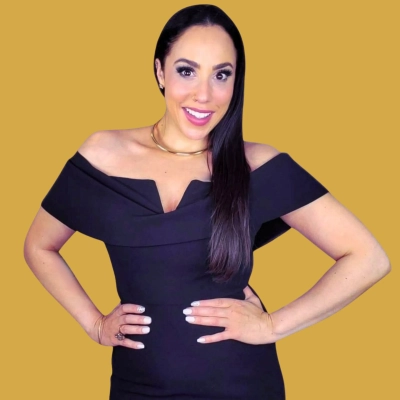Attracting initial customers is a crucial challenge for new businesses. We asked industry experts to share one piece of advice they’d give to a new entrepreneur who’s just starting to think about finding customers —and the most important thing to focus on in the beginning. These strategies offer practical approaches to build a strong customer base.
- Understand Your Customers’ True Motivations
- Focus on Finding the Right First Customers
- Commit to a Niche for Faster Growth
- Pursue Attention Through Diverse Outreach Methods
- Engage in Direct, Grassroots Customer Acquisition
- Leverage Your Personal Network for Feedback
- Listen to Potential Customers’ Real Problems
- Align Your Purpose with Business Strategy
- Prioritize Customer Love Over Lukewarm Interest
- Validate Demand Before Investing in Branding
- Identify and Solve Pressing Customer Problems
- Build Scalable Solutions, Not Just Services
- Gain Credibility Through Strategic Exposure
- Establish a Clear Brand Identity
- Foster Authentic Relationships with Empathy
- Be Selective About Your Customer Base
- Understand Your Ideal Customer’s Pain Points
- Verify Problem Existence and Customer Readiness
Finding Your First Customers: Advice from Seasoned Entrepreneurs
Understand Your Customers’ True Motivations
When I first started my business, it ran on optimism, enthusiasm, and a massive amount of outreach. Although it did fairly well, considering I was flying by the seat of my pants and figuring it out as I went, if I had to do it again, I would focus on the offer and truly understand what my customers were buying.
People don’t buy products; they buy what they believe that product will give them. If you’re selling t-shirts, what do your ideal customers really want? Are they buying sustainability from the fabric you use? Status from the brand you’re building? A sense of community from the style you sell?
The same goes for services. Are they buying their time back? Peace of mind? Confidence? Clarity? Whatever it is, get clear on the result they truly want, because that’s what they’re paying you for.
Understand your ideal customers intimately: their values, their desires, their innermost motivations. Start by getting to know them better than anyone else, and then speak directly to what they care about most, especially if you’re utilizing social media. Do that, and you won’t have to chase customers. They’ll find you.
 Lisa Jeffs
Lisa Jeffs
CEO & Founder, Lisa Jeffs Toronto Life Coach & Toronto Executive Coach
Focus on Finding the Right First Customers
When I was starting out, I made the mistake of thinking I needed everyone to be my customer. The truth? In the early days, you should obsess over finding your first few right customers.
When I started, I didn’t blast ads everywhere. I went deep into conversations, LinkedIn messages, emails, and small networking events where my ideal clients already hung out. I listened more than I pitched. I wanted to understand their pain points so well that my offer felt like a direct solution, instead of a sales script.
Your first customers are more than revenue; they’re your proof of concept, your case studies, your word-of-mouth engine. Nail their experience, document the results, and you’ll have the leverage to attract the next ten without begging for attention.
 Bhavik Sarkhedi
Bhavik Sarkhedi
Founder & CEO, Ohh My Brand
Commit to a Niche for Faster Growth
When you are just starting out, it is natural to want to speak to as many potential customers as possible, but that usually ends up diluting your impact. I learned this firsthand when I launched Manifest. In the early months, I was eager to meet with almost anyone, from tech startups to manufacturers to professional services firms. On paper, it felt productive, but in reality, my message was too broad and too generic to resonate strongly with anyone. The real progress began when I made a deliberate decision to focus solely on advertising, PR, creative, and digital agencies. That shift allowed me to immerse myself fully in their world, understand their specific pain points, and craft solutions that felt completely relevant to them.
The benefit of focusing on one audience is that you start building a reputation much faster. You learn the language they use, you understand the issues that keep them awake at night, and you can reflect those insights back in your conversations and marketing. This creates an immediate sense of familiarity and trust, which is crucial when you have no track record yet. By contrast, trying to please everyone leaves you sounding vague and interchangeable.
My advice is to pick a niche and commit to it early, even if it feels counterintuitive to turn down other opportunities. In the beginning, depth beats breadth. A smaller, clearly defined audience is easier to reach, easier to impress, and easier to turn into loyal advocates. Once you know exactly who you are talking to, spend as much time as possible listening before you try to sell anything. Arrange calls, meet for coffee, attend industry events, and simply ask people what they are struggling with and what they wish someone would solve for them.
The answers you get will shape everything from how you present your offer to the words you use in your emails and proposals. This is the stage where you lay the foundations for long-term relationships. If you can demonstrate that you understand your audience better than anyone else, your early customers will not just buy from you, they will introduce you to others. Finding your first clients then becomes less about cold selling and more about being recognized as the obvious choice within your chosen space.
 Adam Whittaker
Adam Whittaker
CEO, Manifest New Business Ltd
Pursue Attention Through Diverse Outreach Methods
Attention! Get it anywhere you can and try everything.
Start with door to door sales (literally that is how we got our first customers as a marketing agency), find cheap opportunities to advertise such as small local sports clubs with high footfall, get into charity work and donate product or service, then use any positive outcome to get featured in the press and promote on social media and your website.
Definitely join your local chamber of commerce and any relevant clubs as conversation will happen and you are highly likely to get customers directly or be introduced to the right people. Bonus tip, you might get some valuable advice and mental support in your journey from people that have been there before.
Finally, think of who your business can truly benefit and add value. If you find a true fit and what you offer solves a problem 100% for someone, pick up the phone and call. You’ll be surprised at how receptive people are when you talk to them about something they need.
When you’re starting out people don’t know you and if you want to succeed you need to focus all your time and energy to change this.
 Thanos Zeppos
Thanos Zeppos
Co-Founder, BRINQQ Marketing
Engage in Direct, Grassroots Customer Acquisition
When it comes to finding your very first customers, my top advice for new entrepreneurs is simple yet powerful: hand-to-hand combat. We acquired our initial 100-500 customers through direct, grassroots outreach.
We actively participated in local Facebook groups, posted strategically on Craigslist, and even spent time hanging out at Starbucks, offering gift cards to people willing to test and provide feedback on our platform. This hands-on approach allowed us to deeply understand our customers’ needs and refine our offering effectively.
By personally securing those first crucial customers, you not only validate your business idea but also discover exactly what messaging and methods resonate best. Nail it first, then scale it — that’s the proven path to long-term growth.
 Bryan Clayton
Bryan Clayton
Founder, GreenPal
Leverage Your Personal Network for Feedback
When you’re just starting to find customers, don’t underestimate the power of your personal network. You’d be surprised how many second-degree connections — people you’ve barely spoken to — become curious and invested in what you’re building. Early on, we often feel pressure to keep things overly professional, as if asking people we already know to buy from us is “cheating.” But instead of seeing them as easy sells, treat them as valuable feedback loops. Their reactions, questions, and suggestions can help you refine your product or service faster than any anonymous audience. Focus on learning and adapting more than selling at the start — your strongest foundation will come from genuine relationships and honest conversations.
 Joyce Tsang
Joyce Tsang
Content Marketer and Founder, Joyce Tsang Content Marketing
Listen to Potential Customers’ Real Problems
If you’re just starting out, get out and talk to people who might actually buy from you. Not just one or two, but a lot. And don’t pitch them; just ask questions.
When I was starting my second business, I must have spoken to dozens of business owners before we had anything real to sell. I’d ask what kept them up at night, what they’d already tried, and where they felt they were wasting money. Half the time, their answers had nothing to do with what I thought we were going to build. That was the gold.
At the start, it’s not about the logo or the website or some clever tagline. It’s about hearing the same problem come up again and again until you can explain it better than your future customers can. When you get to that point, finding the right offer becomes a lot easier.
 Gustav Westman
Gustav Westman
Founder & CEO, Niora AI
Align Your Purpose with Business Strategy
New entrepreneurs often jump straight into defining their target audience. It makes sense — customer clarity is key to building the right offer. But here’s the advice I always give first:
Before you focus on your customer, get crystal clear on yourself.
The best founders know who they are, what they value, and why this business matters — before they chase traction. That clarity doesn’t just fuel your pitch. It powers your resilience when things get hard (and they will).
Most entrepreneurs are driven by a desire to serve or a passion for solving problems. But if you skip the internal work, your messaging won’t land, your offers will lack depth, and your leadership may wobble under pressure. Customers can sense when something’s off — even if you can’t name it yet.
Start with your purpose. What’s the deeper reason you’re building this? It doesn’t have to be your life’s calling, but it should be rooted in truth. When your identity aligns with your business, your decisions get sharper, your voice gets clearer, and your customers feel it.
Blind spots in self-awareness often show up as misalignment in strategy, branding, or culture. I remind clients all the time: There are no business problems — just personal problems that show up in your business.
Here’s the bottom line: if you want loyal customers, start by being loyal to your own clarity. Your commitment, values, and leadership show up whether you name them or not. Define them early. It will shape everything. That matters, because you will become beholden to it once it becomes an artifact in your business’ journey.
I work with leaders navigating transformation, pivots, and scale. Every time, we start here — because how you lead yourself sets the tone for how you lead others. The strongest brand positioning in the world won’t fix unclear leadership.
So if you’re just starting out, don’t just ask, “Who is my customer?” Ask: “Who am I, and why does this matter to me?” The answer to that question is where everything begins.
 Anika Apple
Anika Apple
Founder & CEO, Remarkably Me Enterprises
Prioritize Customer Love Over Lukewarm Interest
It’s better to have 100 customers love you than 1,000 customers who kinda like you. Seek out those first 100 customers that love your product, study them, and double down on delivering what they love. Do this, and you’ll have a clear roadmap for finding the next 100 that love your product. By trying to boil the ocean and service every customer’s wishes, you’ll end up with an unclear product roadmap and a frustrating journey ahead.
 Nick O’Brien
Nick O’Brien
CEO, Templi
Validate Demand Before Investing in Branding
Don’t waste time on logos, color schemes, or branding until you’ve proven people actually want what you’re selling.
When Justin Mares launched Kettle & Fire in 2015, he spent just $500 testing demand through ads on Facebook, Google, and Bing. The logo? A $10 Fiverr job. The site? A basic landing page that accepted payments.
What mattered most was whether the offer resonated. It did — and Kettle & Fire went on to generate $2.8 million in sales in their first year.
Focus on validation. If the offer is strong, everything else can be built around it.
 LIAM LAWSON
LIAM LAWSON
COO, The AI Report
Identify and Solve Pressing Customer Problems
Find people who truly experience the problem you’re trying to solve, not just potential customers you imagine. Talk to 10-15 people in your target group and have open conversations with them before building anything substantial. Ask them about their challenges (not what they wish they had), and pay attention to any frustrations, repeated phrases, or makeshift solutions they’re using.
In the early stages, the key is to identify the real problem, not focus on branding, automation, or advertising. If you solve a pressing problem, people will naturally spread the word, and your idea will gain traction. Don’t worry too much about finding customers as if it’s just marketing. Instead, focus on gaining their trust by demonstrating that you understand them better than anyone else does.
 Felix Lucian
Felix Lucian
CEO, Felix Happich Consultancy
Build Scalable Solutions, Not Just Services
Don’t start by asking, “How can I find customers?”
Start by asking, “What urgent problem can I solve and how can I solve it at scale?”
Because here’s the thing most people realize too late: if you build a business that revolves around you, then congratulations, you’ve built a job with no boss. And worse hours.
That’s the curse of the one-man band. You wear every hat, answer every email, fulfill every service, and eventually, your growth becomes your prison.
So yes, go find problems worth solving. But also design the solution so that you don’t have to be the one delivering it forever.
- Can it be templated?
- Can it be delegated?
- Can a system or process do 80% of the heavy lifting?
Your real product isn’t the service you offer; it’s the machine you build that delivers it without your constant presence.
Finding customers is important. But building something that can serve them without bottlenecking through you — that’s where you actually build a business.
 Adnan Sakib
Adnan Sakib
Creative Director, Nitro Media Group
Gain Credibility Through Strategic Exposure
The majority of new entrepreneurs concentrate on acquiring customers through direct promotion; however, one of the less-utilized strategies is gaining strategic exposure where other businesses have already established customer trust. I examine their current mentions, media placements, and public relationships, then position my brand within those same ecosystems with a more valuable pitch. This approach reduces the time it takes for a new audience to accept a product, as the similarity to what they recognize diminishes rejection.
In the blockchain market, I have introduced early-stage projects to media outlets where established brands in the same sector are already published. This strategy can provide immediate credibility even without significant advertising expenditures, as consumers view the brand in a trusted context — an environment they are already familiar with. The goal is not to mimic the competition but to use their platform to gain momentum and recognition faster. This approach also allows for saving months of outbound prospecting and provides more rapid access to places where purchasing decisions are made.
 Suvrangsou Das
Suvrangsou Das
Global PR Strategist & CEO, EasyPR LLC
Establish a Clear Brand Identity
I work with people who are starting their own clothing brands every day, and the biggest thing that sets the best stores apart from the ones that struggle is this: a clear identity and target audience. Within the first few seconds of arriving on your site or on your social media channels, it needs to be obvious who you create products for.
Often, stores using our services will use generic mockup photography or throw a load of random designs onto their stores without thinking through who they are appealing to. You can probably go more niche than you think — it’s better to nail your products and messaging for a smaller audience than get lost trying to be everything to everyone. To you, it might feel repetitive, but you have to think: “What one thing do I want to be known for by my customers?” and do that really well. There’s no room for much more in their heads.
 Sara Debreceni
Sara Debreceni
Platform Content Lead, Teemill Tech
Foster Authentic Relationships with Empathy
Build authentic relationships rooted in empathy and trust. People are more likely to engage with a business when they feel seen, understood, and valued as individuals, not just as buyers. Taking time to listen, validate their needs and experiences, and understand their motivations can help reduce anxiety on both sides and foster a sense of connection.
Approaching potential customers with genuine curiosity and openness lays the groundwork for long-term loyalty and word-of-mouth growth. In short, focus on cultivating real human connections, and let those relationships guide how you shape and grow your business.
 Angela Ficken
Angela Ficken
Psychotherapist and Entrepreneur, Progress Wellness
Be Selective About Your Customer Base
When you’re just starting out, it’s incredibly tempting to say yes to every potential customer. You want momentum, revenue, and validation — and that often means doing more for less. However, be careful. Not all customers are worth it. The wrong ones can drain your time, energy, and resources — especially those who don’t respect boundaries or delay payments. My advice is: as soon as you’re able, get clear on the value of your work and be selective about whom you serve. The right customers will help you grow — a bad one can set you back.
 Jessica Rich
Jessica Rich
Owner, Bona Dea Naturals
Understand Your Ideal Customer’s Pain Points
Before you start thinking about finding customers, make sure you have the capacity to take financial risk — because the startup phase can be unpredictable. Revenue might be slow, inconsistent, or come from places you didn’t expect. So having a cushion and a clear understanding of your personal financial runway is key.
Once you’re in motion, the most important thing to focus on is understanding your ideal customer and solving a real problem for them. It’s easy to get distracted by branding, social media, or trying to be everywhere at once. But early on, clarity beats complexity. Who are you helping? What’s the pain point? And why are you the right person to solve it?
The more specific you get, the easier it is to attract the right people and build trust. You don’t need a huge audience — you need the right one. Focus on conversations, not campaigns. Listen more than you pitch. And don’t be afraid to refine your offer as you learn what actually resonates.
 Alex Sierra
Alex Sierra
Certified Financial Planner™, Cetera Investors
Verify Problem Existence and Customer Readiness
Rather than giving advice, I would ask them this: “Have you talked to any customers who you would consider early adopters?” If so, did you find that they had the problem you are solving, knew they had the problem, had a negative emotion about having the problem, and were actively looking for a solution to the problem that you solve? If not, where do you think your ideal product buyer or product user is in the physical world and in the digital world?
The most important things to focus on in the beginning are understanding if the problem exists, how many people have the problem, how many people have severe enough pain to solve the problem, and do you know where these people are?
 Ryan Kauth
Ryan Kauth
Coach for Family Business Owners & Serial Founders
 Lisa Jeffs
CEO & Founder, Lisa Jeffs Toronto Life Coach & Toronto Executive Coach
Lisa Jeffs
CEO & Founder, Lisa Jeffs Toronto Life Coach & Toronto Executive Coach
 Bhavik Sarkhedi
Founder & CEO, Ohh My Brand
Bhavik Sarkhedi
Founder & CEO, Ohh My Brand
 Adam Whittaker
CEO, Manifest New Business Ltd
Adam Whittaker
CEO, Manifest New Business Ltd
 Thanos Zeppos
Co-Founder, BRINQQ Marketing
Thanos Zeppos
Co-Founder, BRINQQ Marketing
 Bryan Clayton
Founder, GreenPal
Bryan Clayton
Founder, GreenPal
 Joyce Tsang
Content Marketer and Founder, Joyce Tsang Content Marketing
Joyce Tsang
Content Marketer and Founder, Joyce Tsang Content Marketing
 Gustav Westman
Founder & CEO, Niora AI
Gustav Westman
Founder & CEO, Niora AI
 Anika Apple
Founder & CEO, Remarkably Me Enterprises
Anika Apple
Founder & CEO, Remarkably Me Enterprises
 Nick O’Brien
CEO, Templi
Nick O’Brien
CEO, Templi
 LIAM LAWSON
COO, The AI Report
LIAM LAWSON
COO, The AI Report
 Felix Lucian
CEO, Felix Happich Consultancy
Felix Lucian
CEO, Felix Happich Consultancy
 Adnan Sakib
Creative Director, Nitro Media Group
Adnan Sakib
Creative Director, Nitro Media Group
 Suvrangsou Das
Global PR Strategist & CEO, EasyPR LLC
Suvrangsou Das
Global PR Strategist & CEO, EasyPR LLC
 Sara Debreceni
Platform Content Lead, Teemill Tech
Sara Debreceni
Platform Content Lead, Teemill Tech
 Angela Ficken
Psychotherapist and Entrepreneur, Progress Wellness
Angela Ficken
Psychotherapist and Entrepreneur, Progress Wellness
 Jessica Rich
Owner, Bona Dea Naturals
Jessica Rich
Owner, Bona Dea Naturals
 Alex Sierra
Certified Financial Planner™, Cetera Investors
Alex Sierra
Certified Financial Planner™, Cetera Investors
 Ryan Kauth
Coach for Family Business Owners & Serial Founders
Ryan Kauth
Coach for Family Business Owners & Serial Founders







